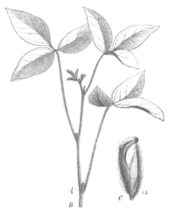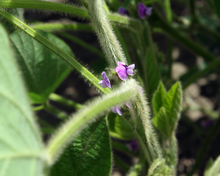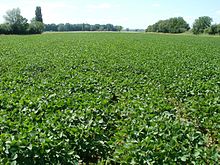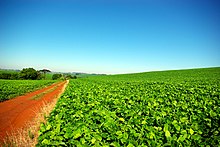Soybean
![]()
Soy is a redirect to this article. For other meanings, see Soy (disambiguation).
The soybean (Glycine max (L.) Merr. ), often referred to simply as soybean (from Jap. shōyu for soy sauce, daizu for soybeans), is a species of plant in the butterfly family (Faboideae) within the legume family (Leguminosae or Fabaceae).
The cultivation of the crop soybean as a food crop has been documented since 3050 BC in Japan and at least since 1550 BC in Korea and China. Soybean is now grown on 6% of global agricultural land and is the world's most important oilseed. Its increasing importance is reflected in the highest growth in cultivated area of any crop since the 1970s. While 17 million tonnes were produced in 1960, this figure had already risen to 334.9 million tonnes by 2016.
As an oilseed, soybeans contain about 20 % oil. The soybean oil is mainly used as food, but also, for example, for the production of biodiesel. After oil pressing, the remaining extraction meal (soybean cake) is heated to destroy the components that are toxic and unhealthy for animals and humans (trypsin inhibitors and hemagglutinins), and then 98 % is fed in animal production and 2 % is used as food for humans. Soybeans contain about 37% protein. As food, the protein quality of soy protein is comparable to animal protein, which sets soybean apart from other plants.
Description and ecology
Vegetative characteristics
The soybean is an annual herbaceous plant with brownish hairs. Since there are very many convarieties and varieties, the morphological characteristics are also very different. Most common are upright growing varieties from 20 to 80 centimetres in height. Tall-growing varieties reach up to two meters in height. The stems are rather thin and more or less branched. Most varieties are finely and densely hairy on stems, petioles and leaves.
There are varieties with unlimited (indeterminate) growth. However, the majority of varieties have limited growth, as the terminal bud of the shoots develops into the inflorescence, and thus the plant does not grow further. In higher latitudes, the former varieties are preferred.
The alternate stem leaves are divided into petiole and leaf blade. The petiole is relatively long. The leaf blade is more than 10 centimetres wide. It is pinnate and usually consists of three leaflets with one or two stipules. The entire leaflets are oval with a length of 3 to 10 centimetres and a width of 2 to 6 centimetres. The leaves are shed when the fruit is still ripe.
Soybeans have pronounced taproots of up to 1.5 meters in length. The roots are colonized by the soybean-specific nodule bacterium Bradyrhizobium japonicum. In this symbiosis, the plant receives the important nutrient nitrogen in plant-available form from the bacteria. When soybeans are grown in soils where the bacteria are not naturally present (such as European soils), the seeds are inoculated with the necessary bacterial symbionts.
Generative characteristics
The soybean is a short-day crop. When grown under long-day conditions, the growth period is extended due to delays in flowering and seed maturation.
The three to twenty axillary flowers are on short branched stalks and are arranged in lateral or terminal racemes. Their colouring usually varies from pale lilac to dark purple. They are relatively small, 5 to 6 millimetres long, and usually self-fertile. The flowering period usually extends over three to four weeks.
The hermaphrodite flowers are zygomorphic and pentate with double perianth. They have ten stamens. Of these, nine stamens are fused into a tube. The tenth, uppermost stamen is free and lies adjacent to the fused stamens. The pistil is straight.
Only 20 to 80 % of the flowers set legumes. The hairy legumes are 2 to 10 centimetres long and straw yellow, grey or black when ripe and contain one to five seeds. The brown, green, or blackish-purple seeds are globose, ovoid, kidney-shaped, flat, or convex. The thousand-seed mass ranges from 50 to 450 grams. Harvesting of soybeans can be fully mechanized by combine harvesters.
Chromosome number
The chromosome number is 2n = 40.
Pests and diseases
Known pests of the soybean plant are the soybean cyst nematode, which belongs to the group of nematodes, the cotton bollworm, various stink bugs (in particular the species Piezodorus guildinii), the Asian soybean rust (Phakopsora pachyrhizi) and the fungus Fusarium virguliforme. The fungus causes sudden death syndrome (SDS), which results in acute death of the soybean plant.

Mature legume

Illustration

Zygomorphic flowers
Economic importance
In the global market for oilseeds (excluding oil crops), soybean has the largest market share of over 55% and an economic value of nearly $50 billion. The world harvest in 2019 was 333,671,692 tonnes. The total cultivated area was over 120.5 million hectares. The top 10 producers together produced about 96.2% of the total world crop. The largest producer was Brazil, which alone contributed about 34.2% of the world crop.
The largest soy producers
| Largest soy producers in the world (2019) | ||
| Rank | Country | Quantity |
| 1 | Brazil | 114.269.392 |
| 2 | United States | 96.793.180 |
| 3 | Argentina | 55.263.891 |
| 4 | China People's Republic of | 15.724.000 |
| 5 | India | 13.267.520 |
| 6 | Paraguay | 8.520.350 |
| 7 | Canada | 6.045.100 |
| 8 | Russia | 4.359.956 |
| 9 | Ukraine Ukraine | 3.698.710 |
| 10 | Bolivia | 2.990.845 |
| Total TOP TEN | 320.932.944 | |
| remaining countries | 12.738.748 | |
Soy production in Germany, Austria and Switzerland
(Rank refers to world production).
| Soy production DACH (2019) | ||
| Rank | Country | Quantity |
| 26 | Austria | 217.780 |
| 39 | Germany | 84.100 |
| 68 | Switzerland | 5.350 |
| DACH | 307.230 | |
World trade
In 2019, 155,385,681 tonnes of soybeans were exported globally. The ten largest trading nations together exported 98.7% of this.
| Largest soybean exporters (2019) | ||
| Rank | Country | Quantity |
| 1 | Brazil | 74.073.074 |
| 2 | United States | 52.388.397 |
| 3 | Argentina | 10.053.802 |
| 4 | Paraguay | 4.901.483 |
| 5 | Canada | 4.012.915 |
| 6 | Uruguay | 2.971.171 |
| 7 | Ukraine Ukraine | 2.952.824 |
| 8 | Netherlands | 910.370 |
| 9 | Russia | 894.087 |
| 10 | Romania | 269.812 |
| remaining countries | 1.957.746 | |
At 139.2 million tonnes, soybean was the most traded crop in 2017 after corn (141.9 million tonnes) and wheat (141.4 million tonnes). Exporters are mainly the USA and South American countries.
By far the most significant importer (2019) was China (58.4% of global import volume), followed by Mexico (with 3.2%), Argentina (3.0%), Egypt (2.8%) and the Netherlands (2.7%). Total imports in 2019 were around 151.7 million tonnes. While China imported most of its soy from the US until mid-2019, this changed in light of the trade conflict with the US. China now (as of 2020) sources most of its soy from Brazil and Argentina.
A genetically modified (transgenic) soybean that facilitates weed control has been approved since 1996. The plants are resistant to the broad-spectrum herbicide glyphosate (Roundup). In 2015, transgenic seeds were used on 83% of global soybean acreage.
South America
In 2019, South America produced 55.2% of the global soybean crop (equivalent to 184,032,151 tonnes). Acreage in South America was 58.4 million hectares in 2019. Brazil increased its production of soybeans from 42.8 million tons to 114.3 million tons from 2002 to 2019. Brazil supplies almost 100% of its soybean crop to China.
North America
Soybean production amounted to 102,838,280 tonnes. This means that 30.8% of global production in 2019 came from North America (USA + Canada). The main cultivation area here is the so-called Corn Belt in the Midwest of the USA, where almost exclusively corn and soybeans are grown. The US states of Illinois and Iowa have the highest production. More than one-third of US production is exported, and soybean oil is the most common vegetable oil used in food production in the US.
The cultivation of genetically modified soy is also widespread in the USA and Canada.
Asia
In 2019, Asia produced 9.5% of the global soybean crop. China is by far the most important producer on the continent.
Europe
In 2019, Europe produced 3.5% of the global crop. In the EU, soybeans are primarily produced in Italy, Romania and France, and outside the EU in Ukraine, Russia and Serbia. The soybean area in Europe in 2019 was 5.6 million ha with a harvest of 11.7 million tonnes. The EU is the second largest importer of soy, three-quarters of which is used as feed, mainly for chickens and pigs. In 2007, the EU had a demand for 34.5 million tonnes of soybean meal, of which 0.3 million tonnes was produced within its borders. The EU imports 98% of its soy meal for animal feed, mainly from South American countries.
Cultivation in Europe can only be considered where a heat sum of 1500 to 2000 degree-days is achieved in relation to a threshold value of 6 °C during the vegetation period of 150 to 180 days given under European climatic conditions. A soil temperature of around 10 °C is required for the germination of soybean seeds.
Several genetically modified soybeans are approved in the EU for use (subject to labelling) as feed and food, but not for cultivation.
Germany
Soybeans were grown on 28,900 hectares in Germany in 2019. A total of 84,100 tonnes were harvested. Optimal climatic conditions in the growing season of the beans possible under the local climate between the end of April/beginning of May and mid-October are only found at some locations in southern Germany (Upper Rhine lowlands between Freiburg and Mainz, Neckar valley between Stuttgart and Heilbronn, southern Bavaria, especially in the valleys of the Danube, Inn and Rott rivers). Since 1996, the focus has been on organic cultivation. With GMO-free soy, prices well above the world market price could be achieved according to the German Soy Promotion Ring.
From 2011 to 2013, a research project funded with 600,000 € by the BMEL within the framework of the "Bundesprogramm Ökologischer Landbau und andere Formen nachhaltiger Landwirtschaft" (BÖLN) (Federal Programme for Organic Farming and other forms of sustainable agriculture) and led by the Research Institute of Organic Farming Germany ran with the participation of several universities, institutes, companies and associations. The aim of the project was to expand soybean cultivation in Germany through breeding adaptation as well as plant cultivation and processing optimisation. The final report was published in 2014.
Austria
The first soybean cultivation trials in Austria date back to the University of Natural Resources and Applied Life Sciences in 1875. Soybean cultivation first became widespread in the early 1990s. After a decline in the area under cultivation following EU accession in 1995, the area under cultivation has recently risen steadily again and amounted to 69,210 hectares in 2019, the fourth largest value within the EU. Within Austria, soybean cultivation is mainly concentrated in the provinces of Burgenland and Lower Austria, which each cultivate over 18,000 hectares. This is followed by Upper Austria, Styria and Carinthia (2019).
In 2010-2019, the average annual harvest increased from 94,544 to 217,000 tonnes. About 50 % of the harvest is processed as edible soy into food (e.g. soy milk, tofu). Several companies in the Austrian growing areas, where only GMO-free seeds are used (as required by law), specialise in processing and export throughout the EU. Organic farming is practiced on 6,300 hectares (2011), about 20% of the cultivated land. In 2019, 69,210 hectares produced 217,780 tonnes of soy. In the same year, organic shares were highest in Vienna with 57%, in Burgenland with 44% and in Lower Austria with 41%.

Soybean field near Hockenheim (2011)

Soybean field in Clinton County (Indiana), ready for harvesting

Soybean field in Rio Grande do Sul (Brazil), 2008

Organic soybean cultivation near Wäldi, Canton Thurgau, Switzerland
Search within the encyclopedia